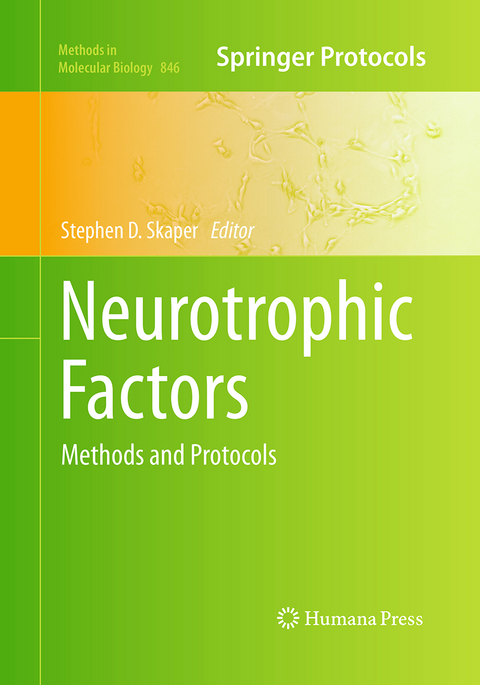
Neurotrophic Factors
Humana Press Inc. (Verlag)
978-1-4939-6210-5 (ISBN)
Authoritative and easily accessible, Neurotrophic Factors: Methods and Protocols seeks to serve both professionals and novices alike with its well-honed methodologies in an effort to further our knowledge ofwhat has been described as the last frontier of science.
The Neurotrophin Family of Neurotrophic Factors – An Overview.- Neuronal Growth-Promoting and Inhibiting Cues in Neuroprotection and Neurodegeneration.- Culture of Rat Cerebellar Granule Neurons and Application to Identify Neuroprotective Agents.- Isolation and Culture of Neural Progenitor Cells from Rat Postnatal Cerebellum.- Culture of Rodent Cortical and Hippocampal Neurons.- Amyloid β-Peptide Neurotoxicity Assay Using Cultured Rat Cortical Neurons.- Culture of Neonatal Rodent Microglia, Astrocytes, and Oligodendrocytes from Cortex and Spinal Cord.- Central Nervous System Neuron-Glia Co-Culture Models.- Culture and Characterization of Rat Mesencephalic Dopaminergic Neurons.- Preparation of Adult Spinal Cord Motor Neuron Cultures Under Serum-Free Conditions.- Rodent Retinal Ganglion Cell Cultures.- Culture of Purified Glial Cell Populations from Optic Nerve.- Isolation and Culture of Rat Cone Photoreceptor Cells.- Rat Retina Pigmented Epithelial Cells.- Mammalian Growth Cone Turning Assays Identify Distinct Cell Signalling Mechanisms that Underlie Axon Growth, Guidance and Regeneration.- Culture of Dissociated Sensory Neurons from Dorsal Root Ganglia of Postnatal and Adult Rats.- Culture and Proliferation of Highly Purified Adult Schwann Cells from Rat, Dog, and Man.- Use of PC12 Cells and Rat Superior Cervical Ganglion Sympathetic Neurons as Models for Neuroprotective Assays Relevant to Parkinson’s Disease.- Compartmented Chambers for Studying Neurotrophic Factor Action.- Preparation and Culture of Adrenal Chromaffin Cells.- Indirect Immunofluorescence Staining of Cultured Neural Cells.- Neurite Outgrowth Assessment Using High Content Analysis Methodology.- Dissociated Cell Culture for Testing Effects of Carbon Nanotubes on Neuronal Growth.- High-Resolution Imaging and Evaluation of Spines in Organotypic Hippocampal Slice Cultures.- Imaging Amyloid Precursor Protein In Vivo – An Axonal Transport Assay.- The Use of Specific AAV Serotypes to StablyTransduce Primary CNS Neuron Cultures.- Preparation and Characterization of Biocompatible Chitosan Nanoparticles for Targeted Brain Delivery of Peptides.- [3H]Serotonin Release Assay Using Antigen-Stimulated Rat Peritoneal Mast Cells.- Rat Hippocampal Slice Culture Models for the Evaluation of Neuroprotective Agents.- A 6-Hydroxydopamine In Vivo Model of Parkinson’s Disease.- Brain Microdialysis in Freely Moving Animals.- Evaluating Motor Neuron Death in Neonatal Rats Subjected to Sciatic Nerve Lesion.- Rodent Spinal Cord Injury Model and Application of Neurotrophic Factors for Neuroprotection.
| Erscheinungsdatum | 19.08.2017 |
|---|---|
| Reihe/Serie | Methods in Molecular Biology ; 846 |
| Zusatzinfo | XIV, 421 p. |
| Verlagsort | Totowa, NJ |
| Sprache | englisch |
| Maße | 178 x 254 mm |
| Themenwelt | Medizin / Pharmazie ► Medizinische Fachgebiete ► Neurologie |
| Medizin / Pharmazie ► Studium | |
| Naturwissenschaften ► Biologie ► Humanbiologie | |
| Naturwissenschaften ► Biologie ► Zoologie | |
| ISBN-10 | 1-4939-6210-8 / 1493962108 |
| ISBN-13 | 978-1-4939-6210-5 / 9781493962105 |
| Zustand | Neuware |
| Haben Sie eine Frage zum Produkt? |
aus dem Bereich


